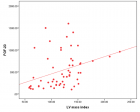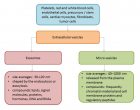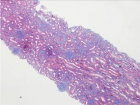Abstract
Research Article
Texture Analysis of Hard Tissue Changes after Sinus Lift Surgery with Allograft and Xenograft
Mohammad Azimzadeh, Farzad Esmaeili, Narges Bayat, Kasra Rahimipour and Amir Ebrahimpour Tolouei*
Published: 29 April, 2024 | Volume 9 - Issue 1 | Pages: 019-022
In the realm of dental surgery, implants are essential for replacing missing teeth. To facilitate implant placement, techniques such as bone grafting and sinus lifts are utilized to augment the volume of atrophied alveolar bone in candidates for dental implants. Typically, patients undergo a period of recovery following bone grafts before proceeding with implant placement. This study investigates the efficacy of Cone Beam Computed Tomography (CBCT) in measuring the residual bone volume and assessing bone quality after the healing phase. A texture analysis was conducted on CBCT scans from 42 patients requiring maxillary sinus lift reconstruction. These patients were categorized into two groups based on the type of grafting material used: Xenograft or allograft. The study analyzed the distribution of various texture parameters and conducted a Mann-Whitney U test to identify significant statistical differences between the groups. Results indicated non-normal distributions for specific variables such as Area_S(1,0) and S(1,0)SumOfSqs, while others like S(1,0)Entropy displayed normal distributions. The findings revealed no significant statistical differences in the primary outcomes between the xenograft and allograft groups. However, the average values of the gray shades of pixels in the allograft group were statistically significantly higher compared to the xenograft group, suggesting differences in bone texture post-procedure.
Read Full Article HTML DOI: 10.29328/journal.johcs.1001049 Cite this Article Read Full Article PDF
Keywords:
Diagnostic imaging; Texture analysis; Maxillary sinus; Allografts; Xenografts
References
- Block MS, Kent JN. Maxillary sinus grafting for totally and partially edentulous patients. J Am Dent Assoc. 1993 May;124(5):139-43. doi: 10.14219/jada.archive.1993.0127. PMID: 8482771.
- Chanavaz M. Maxillary sinus: anatomy, physiology, surgery, and bone grafting related to implantology--eleven years of surgical experience (1979-1990). J Oral Implantol. 1990;16(3):199-209. PMID: 2098563.
- Del Fabbro M, Testori T, Francetti L, Weinstein R. Systematic review of survival rates for implants placed in the grafted maxillary sinus. Int J Periodontics Restorative Dent. 2004 Dec;24(6):565-77. PMID: 15626319.
- Froum SJ, Tarnow DP, Wallace SS, Rohrer MD, Cho SC. Sinus floor elevation using anorganic bovine bone matrix (OsteoGraf/N) with and without autogenous bone: a clinical, histologic, radiographic, and histomorphometric analysis--Part 2 of an ongoing prospective study. Int J Periodontics Restorative Dent. 1998 Dec;18(6):528-43. PMID: 10321168.
- Hockers T, Abensur D, Valentini P, Legrand R, Hammerle CH. The combined use of bioresorbable membranes and xenografts or autografts in the treatment of bone defects around implants. A study in beagle dogs. Clin Oral Implants Res. 1999 Dec;10(6):487-98. doi: 10.1034/j.1600-0501.1999.100607.x. PMID: 10740458.
- Tadjoedin ES, de Lange GL, Holzmann PJ, Kulper L, Burger EH. Histological observations on biopsies harvested following sinus floor elevation using a bioactive glass material of narrow size range. Clin Oral Implants Res. 2000 Aug;11(4):334-44. doi: 10.1034/j.1600-0501.2000.011004334.x. PMID: 11168226.
- Scarano A, Degidi M, Iezzi G, Pecora G, Piattelli M, Orsini G, Caputi S, Perrotti V, Mangano C, Piattelli A. Maxillary sinus augmentation with different biomaterials: a comparative histologic and histomorphometric study in man. Implant Dent. 2006 Jun;15(2):197-207. doi: 10.1097/01.id.0000220120.54308.f3. PMID: 16766904.
- Hatano N, Shimizu Y, Ooya K. A clinical long-term radiographic evaluation of graft height changes after maxillary sinus floor augmentation with a 2:1 autogenous bone/xenograft mixture and simultaneous placement of dental implants. Clin Oral Implants Res. 2004 Jun;15(3):339-45. doi: 10.1111/j.1600-0501.2004.00996.x. PMID: 15142097.
- Kim YK, Kim SG, Lee BG. Bone graft and implant. Narae, Seoul, Korea. 2007; 169-261.
- Graziani F, Ducci F, Tonelli M, El Askary AS, Monier M, Gabriele M. Maxillary sinus augmentation with platelet-rich plasma and fibrinogen cryoprecipitate: a tomographic pilot study. Implant Dent. 2005 Mar;14(1):63-9. doi: 10.1097/01.id.0000156387.35521.bf. PMID: 15764947.
- Gonçalves BC, de Araújo EC, Nussi AD, Bechara N, Sarmento D, Oliveira MS, Santamaria MP, Costa ALF, Lopes S. Texture analysis of cone-beam computed tomography images assists the detection of furcal lesion. J Periodontol. 2020 Sep;91(9):1159-1166. doi: 10.1002/JPER.19-0477. Epub 2020 Feb 26. PMID: 32003465.
- Wannfors K, Johansson B, Hallman M, Strandkvist T. A prospective randomized study of 1- and 2-stage sinus inlay bone grafts: 1-year follow-up. Int J Oral Maxillofac Implants. 2000 Sep-Oct;15(5):625-32. PMID: 11055129.
- Galindo-Moreno P, Avila G, Fernández-Barbero JE, Aguilar M, Sánchez-Fernández E, Cutando A, Wang HL. Evaluation of sinus floor elevation using a composite bone graft mixture. Clin Oral Implants Res. 2007 Jun;18(3):376-82. doi: 10.1111/j.1600-0501.2007.01337.x. Epub 2007 Mar 12. PMID: 17355356.
- Herzberg R, Dolev E, Schwartz-Arad D. Implant marginal bone loss in maxillary sinus grafts. Int J Oral Maxillofac Implants. 2006 Jan-Feb;21(1):103-10. PMID: 16519188.
- Rodoni LR, Glauser R, Feloutzis A, Hämmerle CH. Implants in the posterior maxilla: a comparative clinical and radiologic study. Int J Oral Maxillofac Implants. 2005 Mar-Apr;20(2):231-7. PMID: 15839116.
- Simion M, Trisi P, Piattelli A. Vertical ridge augmentation using a membrane technique associated with osseointegrated implants. Int J Periodontics Restorative Dent. 1994 Dec;14(6):496-511. PMID: 7751115.
- Hallman M, Zetterqvist L. A 5-year prospective follow-up study of implant-supported fixed prostheses in patients subjected to maxillary sinus floor augmentation with an 80:20 mixture of bovine hydroxyapatite and autogenous bone. Clin Implant Dent Relat Res. 2004;6(2):82-9. doi: 10.1111/j.1708-8208.2004.tb00030.x. PMID: 15669708.
- Danesh-Sani SA, Loomer PM, Wallace SS. A comprehensive clinical review of maxillary sinus floor elevation: anatomy, techniques, biomaterials and complications. Br J Oral Maxillofac Surg. 2016 Sep;54(7):724-30. doi: 10.1016/j.bjoms.2016.05.008. Epub 2016 May 25. PMID: 27235382.
- Oklund SA, Prolo DJ, Gutierrez RV, King SE. Quantitative comparisons of healing in cranial fresh autografts, frozen autografts and processed autografts, and allografts in canine skull defects. Clin Orthop Relat Res. 1986 Apr;(205):269-91. PMID: 3516501.
- Ditmer A, Zhang B, Shujaat T, Pavlina A, Luibrand N, Gaskill-Shipley M, Vagal A. Diagnostic accuracy of MRI texture analysis for grading gliomas. J Neurooncol. 2018 Dec;140(3):583-589. doi: 10.1007/s11060-018-2984-4. Epub 2018 Aug 25. PMID: 30145731.
- Oliveira MS, Fernandes PT, Avelar WM, Santos SL, Castellano G, Li LM. Texture analysis of computed tomography images of acute ischemic stroke patients. Braz J Med Biol Res. 2009 Nov;42(11):1076-9. doi: 10.1590/s0100-879x2009005000034. Epub 2009 Oct 9. PMID: 19820884.
- Ramkumar S, Ranjbar S, Ning S, Lal D, Zwart CM, Wood CP, Weindling SM, Wu T, Mitchell JR, Li J, Hoxworth JM. MRI-Based Texture Analysis to Differentiate Sinonasal Squamous Cell Carcinoma from Inverted Papilloma. AJNR Am J Neuroradiol. 2017 May;38(5):1019-1025. doi: 10.3174/ajnr.A5106. Epub 2017 Mar 2. PMID: 28255033; PMCID: PMC7960372.
Figures:
Similar Articles
-
Texture Analysis of Hard Tissue Changes after Sinus Lift Surgery with Allograft and XenograftMohammad Azimzadeh, Farzad Esmaeili, Narges Bayat, Kasra Rahimipour, Amir Ebrahimpour Tolouei*. Texture Analysis of Hard Tissue Changes after Sinus Lift Surgery with Allograft and Xenograft. . 2024 doi: 10.29328/journal.johcs.1001049; 9: 019-022
Recently Viewed
-
Changes in the frequency and intensity of Tinnitus using the Suppressive Noise SpectrumMing Zhang*,Alysia Jeske,Sarah Young. Changes in the frequency and intensity of Tinnitus using the Suppressive Noise Spectrum. Adv Treat ENT Disord. 2017: doi: 10.29328/journal.ated.1001002; 1: 006-012
-
Unusual Complications of a Dental Prosthesis Esophageal Foreign Body: About a CaseRichard Edward Alain Deguenonvo,Ndèye Fatou Thiam*,Mouhamadou Diouldé Diallo,Abdou Sy,Amadou Thiam,Abdoulaye Diop,Mame Sanou Diouf,Baye Karim Diallo. Unusual Complications of a Dental Prosthesis Esophageal Foreign Body: About a Case. Adv Treat ENT Disord. 2025: doi: 10.29328/journal.ated.1001016; 9: 001-004
-
Deep Learning-Powered Genetic Insights for Elite Swimming Performance: Integrating DNA Markers, Physiological Biometrics and Performance AnalyticsRahul Kathuria,Reeta Devi,Asadi Srinivasulu*. Deep Learning-Powered Genetic Insights for Elite Swimming Performance: Integrating DNA Markers, Physiological Biometrics and Performance Analytics. Int J Bone Marrow Res. 2025: doi: 10.29328/journal.ijbmr.1001020; 8: 006-015
-
Effectiveness of levocetirizine in treating allergic rhinitis while retaining work efficiencyDabholkar Yogesh, Shah Tanush, Rathod Roheet, Paspulate Akhila, Veligandla Krishna Chaitanya, Rathod Rahul, Devesh Kumar Joshi*, Kotak Bhavesh. Effectiveness of levocetirizine in treating allergic rhinitis while retaining work efficiency. Arch Asthma Allergy Immunol. 2023: doi: 10.29328/journal.aaai.1001031; 7: 005-011
-
The use of the scientific method as dogma can be an obstacle in times of pandemicFelipe Inserra,Walter Manucha*,León Ferder. The use of the scientific method as dogma can be an obstacle in times of pandemic. Insights Clin Cell Immunol. 2021: doi: 10.29328/journal.icci.1001016; 5: 001-002
Most Viewed
-
Causal Link between Human Blood Metabolites and Asthma: An Investigation Using Mendelian RandomizationYong-Qing Zhu, Xiao-Yan Meng, Jing-Hua Yang*. Causal Link between Human Blood Metabolites and Asthma: An Investigation Using Mendelian Randomization. Arch Asthma Allergy Immunol. 2023 doi: 10.29328/journal.aaai.1001032; 7: 012-022
-
Impact of Latex Sensitization on Asthma and Rhinitis Progression: A Study at Abidjan-Cocody University Hospital - Côte d’Ivoire (Progression of Asthma and Rhinitis related to Latex Sensitization)Dasse Sery Romuald*, KL Siransy, N Koffi, RO Yeboah, EK Nguessan, HA Adou, VP Goran-Kouacou, AU Assi, JY Seri, S Moussa, D Oura, CL Memel, H Koya, E Atoukoula. Impact of Latex Sensitization on Asthma and Rhinitis Progression: A Study at Abidjan-Cocody University Hospital - Côte d’Ivoire (Progression of Asthma and Rhinitis related to Latex Sensitization). Arch Asthma Allergy Immunol. 2024 doi: 10.29328/journal.aaai.1001035; 8: 007-012
-
An algorithm to safely manage oral food challenge in an office-based setting for children with multiple food allergiesNathalie Cottel,Aïcha Dieme,Véronique Orcel,Yannick Chantran,Mélisande Bourgoin-Heck,Jocelyne Just. An algorithm to safely manage oral food challenge in an office-based setting for children with multiple food allergies. Arch Asthma Allergy Immunol. 2021 doi: 10.29328/journal.aaai.1001027; 5: 030-037
-
Snow white: an allergic girl?Oreste Vittore Brenna*. Snow white: an allergic girl?. Arch Asthma Allergy Immunol. 2022 doi: 10.29328/journal.aaai.1001029; 6: 001-002
-
Cytokine intoxication as a model of cell apoptosis and predict of schizophrenia - like affective disordersElena Viktorovna Drozdova*. Cytokine intoxication as a model of cell apoptosis and predict of schizophrenia - like affective disorders. Arch Asthma Allergy Immunol. 2021 doi: 10.29328/journal.aaai.1001028; 5: 038-040

If you are already a member of our network and need to keep track of any developments regarding a question you have already submitted, click "take me to my Query."

















































































































































